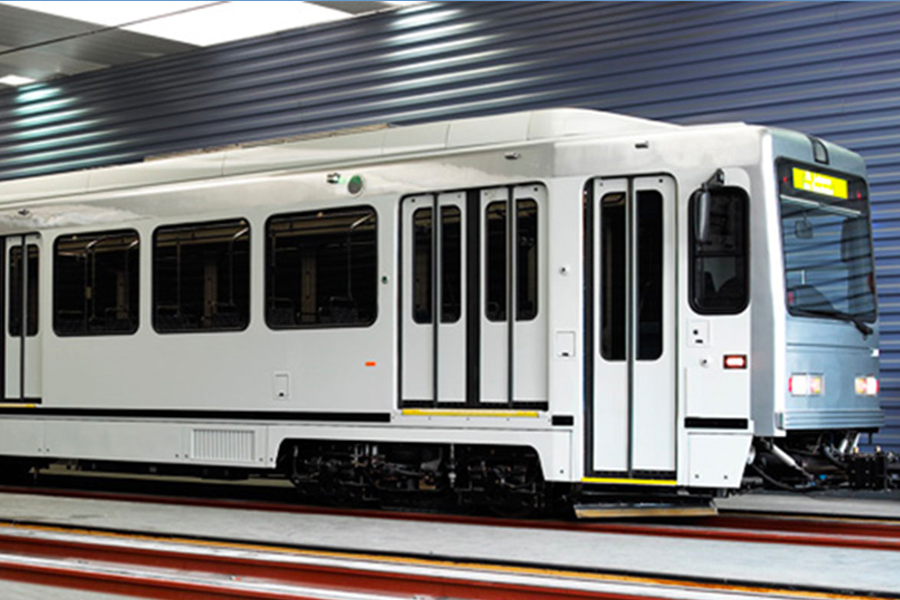
Testing the tracks
On a night in November three years ago on Pittsburgh’s Light Rail system, a passenger train needed to switch tracks to navigate around maintenance work. However, it couldn’t complete the
While a failure to switch tracks caused the derailment in 2012, other more normal factors like wear and tear on tracks can lead to derailment too.
To prevent future accidents, Carnegie Mellon Civil and Environmental Engineering Assistant Professor Hae Young Noh, with Professors Jacobo Bielak (CEE), Jelena Kovačević (ECE), Dean of the College of Engineering Jim Garrett(CEE), and Piervincenzo Rizzo of the University of Pittsburgh, in collaboration with the Port Authority of Alleghany County, are testing new technology to spot possible dangers for trains on tracks before they become problems. The Light Rail system, also called the “T”, is their testing ground.
Noh’s range of research focuses heavily on implementing sensors into structures to improve daily life. In addition to her work with trains, she is using sensors within buildings to detect people for safety and security
This project is part of Carnegie Mellon’s Technology for Safe and Efficient Transportation University Transportation Center (T-SET UTC), which is dedicated to making transportation safer and more efficient by improving roadway infrastructure and technology. The T-SET UTC is funded by the Department of Transportation.
Noh and her collaborators’ technology for the tracks is, quite simply, sensors and data analysis.
The sensors, fitted to passenger cars that run the length of the “T”, pick up vibrations that occur along the track. The vibrations are then collected and analyzed. The measurements, which are a mixture of vibrations from the train itself and vibrations from the interaction between the train and track, can be used to determine where
“Typically, what people do to monitor rail structures is to have individual inspections,” Noh said. “They send out people who walk around the entire rail system, but it’s very
Compared to typical railway inspections, the vibration-collecting sensors present a more uniform and objective way to spot defects.
“There are different types of information all buried in the vibration signals,” Noh said.
Two years ago, Noh and her collaborators fitted one of the passenger cars on the “T” with their sensors. They chose to fit a train, and not the entire track, with the sensors to make the technology more affordable. The T’s train has now been collecting data for two years. Earlier this year, the researchers fitted a second train on the system with their technology.
From the collected data, Noh can identify irregular vibrations and find out where those vibrations occurred in order to pinpoint areas that could be problematic.
In one scenario, the wheels of a rail car were chipping. If the train kept running the same way, a wheel could have eventually cracked and the train could have derailed.
Normally, it would be difficult to determine where on the track the wheels were being chipped. After all, it could be have been occurring anywhere on the track. With the sensors, though, the researchers calculated a handful of areas that impacted the train more than they should have.
At one of those locations, Port Authority found a metal piece on the track that was disturbing the train’s path. They were able to remove the piece to prevent it from further chipping the wheels that ran over the rail.
Not only can the sensors pick up on deterioration in trains and the tracks they run along, but they can also spot deterioration in supporting structures like bridges that the tracks are laid over.
“When a train crosses a bridge, vibration characteristics will be different than when the train is just moving along the ground,” Noh said
The vibrations can be used to find irregularities like cracks in bridges or anything that damages the strength or thickness of a supporting structure.
The technology can also be used to ensure that repairs have successfully fixed a problem on a track by comparing vibrations before the repair to vibrations collected after. In this way, the technology can even help to estimate how a track will deteriorate over time.
Noh has also used sensors like the ones that monitor the “T” to check for deterioration in roadways. She and her collaborators have used the sensors in cars for travel through Oakland and in Palo Alto, Calif. The U.S. Geological Survey has also tested the sensors with the researchers in vehicles around Sherman Island, Calif.’s
This advancement comes at an exciting time for Carnegie Mellon and the city of Pittsburgh, both of which are helping to lead the MetroLab Network, a new initiative announced last week at the White House. The MetroLab Network includes more than 25 universities and 20 metro areas that will develop technologies to confront challenges in urban areas.
With Noh’s research, it is hopeful that in the future, train derailments are a thing of the past.